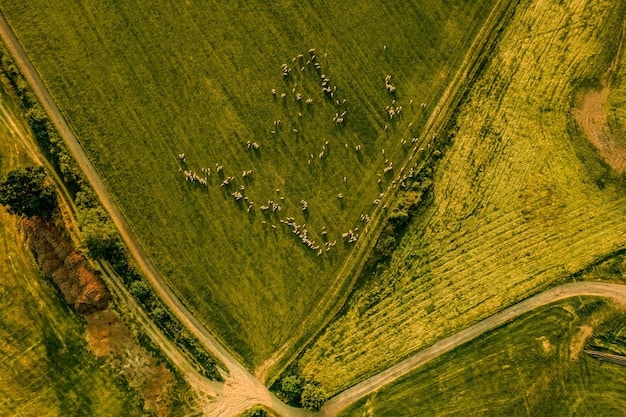Passive Income Blueprint: Invest in Farmland for Consistent Returns in 2025

Investing in farmland as a passive income strategy in 2025 involves purchasing agricultural land and generating income through methods like leasing to farmers, participating in crop sharing, or exploring alternative uses such as solar farms or recreational activities, offering consistent returns and portfolio diversification.
Unlock a world of passive income potential by exploring farmland investments in 2025. This comprehensive Passive Income Blueprint: How to Invest in Farmland and Generate Consistent Returns in 2025 will guide you through every step, from understanding the market dynamics to reaping consistent rewards.
Understanding Farmland as a Passive Income Investment
Farmland, often overlooked in the buzz of traditional investments, presents a tangible and enduring opportunity for passive income. It’s more than just dirt; it’s a vital resource that fuels our world and offers a unique path to financial stability.
In this section, we’ll explore the fundamental aspects of farmland investment, comparing it to other asset classes and highlighting the distinct advantages it offers.
Why Farmland Stands Out
Farmland distinguishes itself through its intrinsic value and connection to essential human needs. Unlike stocks or bonds, farmland provides a tangible asset with potential for appreciation and income generation. Here are some key differentiators:
- Tangible Asset: Farmland is a physical asset, providing a sense of security and control that paper assets often lack.
- Essential Resource: As the global population grows, the demand for food and agricultural products increases, making farmland a consistently valuable resource.
- Diversification: Farmland investments can reduce overall portfolio risk by offering returns that are often uncorrelated with the stock market.

Various Avenues for Earning Passive Income From Farmland
Farmland investing offers many revenue options, which, when combined, produce consistent returns and long-term financial viability. The following are some noteworthy methods:
- Leasing to Farmers: Renting out your land to farmers is a straightforward way to earn income without active involvement in farming operations.
- Crop Sharing: Partner with farmers and share in the profits from the crops grown on your land, potentially increasing your returns.
- Specialty Crops: Cultivating high-value specialty crops, such as organic produce or vineyards, can yield substantial profits but may require more active management.
In conclusion, farmland investment provides a unique and grounded approach to passive income, blending the security of a tangible asset with the enduring demand for agricultural resources. It offers a diversification avenue that can stabilize your portfolio when compared to more conventional assets.
Evaluating Farmland Investment Opportunities in the US
Before diving into farmland investment, it’s crucial to understand the factors that influence its value and potential returns. Careful evaluation is key to identifying promising opportunities and mitigating risks.
This section will guide you through the essential aspects of evaluating farmland, focusing on location, soil quality, water availability, and market trends.
Location, Location, Location
The location of farmland significantly impacts its value and income-generating potential. Consider the following factors when assessing location:
- Proximity to Markets: Farms located closer to urban centers or processing facilities often benefit from lower transportation costs and access to larger markets.
- Climate and Growing Season: Regions with favorable climates and longer growing seasons generally support a wider variety of crops and higher yields.
- Local Regulations: Understanding zoning laws, environmental regulations, and agricultural policies in the area is crucial for long-term investment success.
Assessing Soil Quality and Water Availability
The productivity of farmland hinges on soil quality and access to water. These factors directly influence crop yields and the long-term viability of the investment.
Evaluate the following considerations:
- Soil Composition: Conduct soil tests to determine nutrient levels, pH balance, and drainage characteristics. Healthy soil supports robust crop growth.
- Water Resources: Assess the availability of irrigation water from rivers, wells, or other sources. Water rights and regulations should also be carefully examined.
- Environmental Factors: Look for signs of soil erosion, contamination, or other environmental issues that could impact the land’s productivity.
Analyzing Market Trends and Economic Factors
Staying informed about market trends and economic factors is essential for making sound investment decisions. Monitor crop prices, demand for agricultural products, and broader economic conditions.
Keep up with the following developments:
- Crop Prices: Track the prices of major crops grown in the region and analyze factors that influence price fluctuations, such as weather patterns, global demand, and government subsidies.
- Land Values: Research historical trends in farmland values and assess the factors driving appreciation or depreciation in the area.
- Interest Rates and Financing: Monitor interest rates and financing options available for farmland purchases. Favorable financing terms can enhance investment returns.
In short, assessing farmland investment opportunities in the United States requires a comprehensive approach that considers location, soil quality, water availability, and market dynamics. A thorough analysis of these factors can help investors pinpoint viable investment options and reduce risks.
Financing Your Farmland Investment: Options and Strategies
Securing the right financing is a critical step in acquiring farmland. Understanding the available options and developing a sound financial strategy can make the difference between a successful investment and a missed opportunity.
This section explores various financing options, including agricultural loans, government programs, and alternative funding sources.
Agricultural Loans from Banks and Credit Unions
Agricultural loans are a common financing option for farmland purchases. Banks and credit unions that concentrate on lending to the agricultural sector provide these loans often. Here’s what you should consider:
- Loan Terms: Evaluate interest rates, repayment schedules, and loan duration offered by different lenders. Compare terms carefully to find the most favorable option.
- Collateral Requirements: Understand the collateral requirements for agricultural loans. Farmland itself is typically used as collateral, but additional assets may be required.
- Creditworthiness: Lenders will assess your creditworthiness based on your credit score, financial history, and business plan. Improving your credit profile can increase your chances of securing a loan.

Government Programs and Subsidies
Government programs and subsidies can provide financial assistance and incentives for farmland investments. These programs are designed to support agriculture and rural development. A few examples include:
- Farm Service Agency (FSA) Loans: The FSA offers various loan programs for farmers and ranchers, including direct and guaranteed loans for land acquisition.
- Environmental Quality Incentives Program (EQIP): EQIP provides financial and technical assistance to promote conservation practices on farmland.
- Conservation Reserve Program (CRP): CRP offers rental payments to landowners who agree to remove environmentally sensitive land from agricultural production and plant grasses or trees.
Exploring Alternative Funding Sources
In addition to traditional loans and government programs, explore alternative funding sources for farmland investments. These options can provide flexibility and access to capital that may not be available through conventional channels.
Think about the following:
- Real Estate Investment Trusts (REITs): Invest in publicly traded or private farmland REITs, which own and manage portfolios of agricultural properties.
- Crowdfunding: Raise capital from a large number of investors through online crowdfunding platforms that specialize in agricultural investments.
- Private Equity: Seek funding from private equity firms that invest in agriculture and natural resources.
In summary, financing your farmland investment requires careful planning and exploration of available options. By understanding the terms, conditions, and requirements of different financing sources, you can secure the capital needed to achieve your investment goals.
Managing Your Farmland for Optimal Passive Income
Once you’ve acquired farmland, effective management is essential for maximizing passive income and ensuring the long-term sustainability of your investment. While the goal is passive income, some level of oversight is usually required.
This section provides strategies for managing your farmland, including selecting the right tenants, implementing sustainable practices, and monitoring performance.
Selecting the Right Tenants or Farm Managers
Choosing the right tenants or farm managers is crucial for successful farmland investment. Partnering with experienced and reliable operators can ensure your land is well-maintained and productive. Here are some things to keep in mind:
- Experience and Expertise: Look for tenants or managers with a proven track record in farming and a deep understanding of local agricultural practices.
- Communication and Collaboration: Establish clear communication channels and foster a collaborative relationship with your tenants or managers.
- Financial Stability: Assess the financial stability of potential tenants or managers to ensure they can meet their obligations and invest in the land’s productivity.
Selecting the right tenant is crucial for maximizing passive returns on your farmland investment with minimal involvement.
Implementing Sustainable Farming Practices
Adopting sustainable farming practices not only benefits the environment but also enhances the long-term productivity and value of your farmland. Sustainable practices are environmentally friendly and improve soil health.
These practices include:
- Crop Rotation: Implementing crop rotation strategies can improve soil fertility, reduce pest and disease pressure, and increase crop yields.
- Conservation Tillage: Using conservation tillage methods, such as no-till farming, can reduce soil erosion, conserve water, and improve soil health.
- Integrated Pest Management (IPM): Implementing IPM strategies can minimize the use of synthetic pesticides and promote a balanced ecosystem on your farmland.
Monitoring Performance and Adjusting Strategies
Regularly monitoring the performance of your farmland investment is essential for identifying opportunities for improvement and ensuring your goals are meeting passive income targets. It is crucial to monitor performance and improve strategy.
Consider these evaluation methods:
- Crop Yields: Track crop yields over time to assess the productivity of your land and identify potential issues, such as nutrient deficiencies or pest infestations.
- Financial Performance: Monitor rental income, expenses, and overall profitability to evaluate the financial performance of your investment.
- Market Conditions: Stay informed about market trends, crop prices, and economic factors that could impact your investment.
Ultimately, effective management of farmland for passive income necessitates choosing the right tenants, putting sustainable practices into place, and keeping track of results. Investors may optimize returns and maintain the value of their investment by taking these steps.
Exploring Alternative Uses for Farmland in 2025
Beyond traditional farming, exploring alternative uses for farmland can unlock new income streams and enhance the overall value of your investment. The agricultural landscape is continuously changing, presenting original choices for farmland utilization.
This section examines innovative approaches to farmland use, including solar farms, recreational activities, and agritourism.
Converting Farmland into Solar Farms
Converting farmland into solar farms can generate substantial passive income through long-term lease agreements with solar energy companies. This option provides a steady income stream and contributes to renewable energy production. Here are some advantages of using farmland for solar power:
- Stable Income: Solar leases typically offer fixed annual payments, providing a predictable and stable income stream.
- Reduced Labor: Solar farms require minimal maintenance compared to traditional farming, reducing labor costs and management responsibilities.
- Environmental Benefits: Solar energy is a clean and renewable energy source, contributing to a more sustainable future.
Developing Recreational Activities on Farmland
Developing recreational activities on farmland can attract visitors and generate income through activities such as hunting, fishing, camping, and hiking. You need to consider the demand in your area to make sure that this will be sustainable.
Consider the following to create opportunities and generate revenue:
- Hunting Leases: Lease your land to hunting clubs or individuals for seasonal hunting activities, generating income from hunting permits and access fees.
- Fishing Ponds: Stock ponds with fish and offer fishing permits or guided fishing tours, attracting anglers and generating income from fishing activities.
- Camping and Hiking: Develop campsites and hiking trails on your farmland, attracting outdoor enthusiasts and generating income from camping fees and trail passes.
Agritourism and Educational Opportunities
Agritourism combines agriculture and tourism, offering hands-on experiences for visitors and generating income through farm tours, farm stays, and educational programs. It is important for farmers to diversify their revenue streams to generate income for farmland.
Possible endeavors to consider are:
- Farm Tours: Offer guided tours of your farmland, showcasing agricultural practices, livestock, and crops, and charging admission fees to visitors.
- Farm Stays: Provide lodging accommodations on your farmland, such as cabins or farmhouses, and offer overnight stays to visitors seeking a rural experience.
- Educational Programs: Develop educational programs and workshops on topics such as farming, gardening, and cooking, attracting students and generating income from tuition fees.
Diversifying revenue streams and maximizing the potential returns can be achieved by exploring alternative uses for farmland, such as recreational activities. Investors can attain financial advantages and encourage sustainability, and align their investments with changing market requirements.
Mitigating Risks and Ensuring Long-Term Success
Like any investment, farmland carries inherent risks. Understanding these risks and implementing strategies to mitigate them is essential for ensuring long-term success and protecting your capital.
This section outlines common risks associated with farmland investment, including weather-related challenges, market volatility, and regulatory changes, and offers strategies for managing these risks.
Weather-Related Risks and Insurance
Weather-related events, such as droughts, floods, and extreme temperatures, can significantly impact crop yields and farm profitability. Mitigating these risks requires careful planning and risk management strategies.
The weather has a huge influence on the success of your farm:
- Crop Insurance: Purchase crop insurance to protect against losses due to adverse weather conditions, such as yield reductions or crop failure.
- Irrigation Systems: Invest in irrigation systems to ensure a reliable water supply during dry periods, reducing the impact of droughts on crop production.
- Diversification: Diversify your farming operations by growing a variety of crops or raising livestock to reduce reliance on a single commodity and mitigate the impact of weather-related losses.
Managing Market Volatility and Economic Downturns
Market volatility and economic downturns can impact crop prices, land values, and overall farm profitability. Managing these risks requires a long-term perspective and proactive strategies. Land values and crop prices correlate, it is important to consider that.
Here is how to keep yourself on track:
- Hedging Strategies: Use hedging strategies, such as forward contracts or options, to lock in prices for your crops and protect against price declines.
- Debt Management: Manage your debt levels prudently and avoid over-leveraging your farming operations. Maintain a healthy debt-to-asset ratio to weather economic downturns.
- Emergency Funds: Maintain an emergency fund to cover unexpected expenses or revenue shortfalls during periods of market volatility.
Navigating Regulatory and Environmental Challenges
Regulatory and environmental challenges, such as zoning laws, environmental regulations, and water restrictions, can impact farmland investment. Staying informed and compliant with these regulations is crucial for long-term success. Staying ahead of regulations is key to proper land use.
Here is what you should do:
- Legal Counsel: Consult with legal counsel specializing in agricultural law to ensure compliance with all applicable regulations and protect your legal rights.
- Environmental Compliance: Implement best management practices to minimize environmental impacts, such as soil erosion, water pollution, and habitat loss.
- Community Engagement: Engage with local communities and stakeholders to build positive relationships and address concerns related to your farming operations.
In summary, farmland investors can minimize risks and safeguard their capital for long-term sustainability by utilizing risk mitigation measures. These initiatives encompass acquiring insurance coverage, managing market volatility, and adhering to changing regulations.
| Key Aspect | Brief Description |
|---|---|
| 🚜 Farmland Investment | Invest in agricultural land for income & appreciation. |
| 💰 Financing Options | Explore agricultural loans, government programs, and REITs. |
| 🌱 Sustainable Practices | Use crop rotation and conservation tillage for soil health. |
| 💡 Alternative Uses | Consider solar farms, recreation, or agritourism for extra income. |
Frequently Asked Questions
▼
Farmland is a tangible asset with increasing demand due to population growth. It offers diversification, is less volatile than stocks, and generates income through leasing or crop sharing.
▼
Consider location (proximity to markets, climate), soil quality (nutrient levels, drainage), water availability, and market trends (crop prices, land values) before investing in farmland.
▼
You can explore agricultural loans from banks, government programs like FSA loans, REITs, crowdfunding, and private equity for financing your farmland investment.
▼
Select reliable tenants, implement sustainable farming practices like crop rotation, and regularly monitor crop yields, financial performance, and market conditions to optimize income.
▼
Consider converting farmland into solar farms, developing recreational activities like hunting leases, or exploring agritourism opportunities like farm tours to diversify income streams.
Conclusion
Investing in farmland for passive income in 2025 offers a unique blend of stability and potential growth. By understanding the market, implementing effective management strategies, and mitigating risks, investors can unlock consistent returns and build a resilient financial future.





